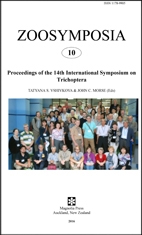Abstract
The Trichoptera assemblages of three springs in the escarpment and on the Waterberg of Namibia, and of two springs in the Great Escarpment of South Africa were collected at irregular intervals. The species composition of each spring is presented and discussed in terms of permanence and stability of spring areas. The study has revealed a poor fauna in the Namibian escarpment, which consists of widespread species whereas the springs on the Waterberg and in the Great Escarpment are more speciose and contain relict and possible endemic species as well as widespread and euryoecious species. The differences are due to different degrees of isolation and distance from other freshwater ecosystems and suitable aquatic biotopes in the arid and semiarid environment of southwestern Africa.
References
Barnard, K.H. (1934) South African caddis-flies (Trichoptera). Transactions of the Royal Society of South Africa, 21 (4), 291–394.
http://dx.doi.org/10.1080/00359193409518885Blümel, W.D., Eberle, J., Hüser, K. & Eitel, B. (2009) Holozäner Klima- und Landschaftswandel in der Namib. Nova Acta Leopoldina, NF, 108 (373), 125−149.
Brook, G.A., Marais, E. & Cowart, J.B. (1999) Evidence of wetter and drier conditions in Namibia from tufas and submerged speleothems. Cimbebasia, 15, 29−39.
Clark, V.R. (2010) The phytogeography of the Sneeuberg, Nuweveldberge and Roggeveldberge (Great Escarpment): Assessing migration routes and endemism. unpublished PhD Thesis, Rhodes University, Grahamstown, 337 pp.
Clark, V.R., Barker, N. & Mucina, L. (2009) The Sneeuberg: A new centre of floristic endemism on the Great Escarpment, South Africa. South African Journal of Botany, 75, 196−238.
http://dx.doi.org/10.1016/j.sajb.2008.10.010Clark, V.R., Barker, N. & Mucina, L. (2011) The Great Escarpment of southern Africa: A new frontier for biodiversity exploration. Biodiversity and Conservation, 20, 2543−2561.
http://dx.doi.org/10.1007/s10531-011-0103-3Clark, V.R., Barker, N. & Mucina, L. (2012) Taking the scenic route—the southern Great Escarpment (South Africa) as part of the Cape to Cairo floristic highway. Plant Ecology & Diversity, 4 (4), 1–16.
http://dx.doi.org/10.1080/17550874.2011.619584Danks, H.V. & Williams, D.D. (1991) Arthropods of springs, with particular reference to Canada: Synthesis and needs for research. Memoirs of the Entomological Society of Canada, 155, 303−217.
http://dx.doi.org/10.4039/entm123155203-1de Moor, F.C. & Scott, K.M.F. (2003) Trichoptera, chapter 5. In: de Moor, I.J., Day, J.A. & de Moor, F.C. (Eds.), Hemiptera, Megaloptera, Neuroptera, Trichoptera & Lepidoptera. Guides to the Freshwater Invertebrates of Southern Africa, 8 (Insecta II), pp. 84–181.
Erman, N. A. (1998) Invertebrate richness and Trichoptera phenology in Sierra Nevada (California, USA) cold springs: Sources of variation. In: Botosaneanu, L. (Ed.), Studies in Crenobiology. Backhuys Publishers, Leiden, pp. 95–108.
Galley, C., Bytebier, B., Bellstedt, D.U. & Linder, H.P. (2007) The Cape element in the Afrotemperate flora: From Cape to Cairo. Proceedings of the Royal Society, B, 274, 535−543.
http://dx.doi.org/10.1098/rspb.2006.0046Heine, K. (2004) Little Ice Age climatic fluctuations in the Namib Desert, Namibia, and adjacent areas: Evidence of exceptionally large floods from slack water deposits and desert soil sequences. Lecture Notes in Earth Sciences, 102, 137−165.
http://dx.doi.org/10.1007/978-3-540-44930-0_9Jacquemart, S. (1963) Chapter IV, Trichoptera. In: Handstroem, B., Brink, P. & Rudebeck, G. (Eds.), South African animal life. Vol. 9. Results of the Lund University expedition in 1950–1951. Statens Naturvetenskapliga Forskningsråd, Stockholm, pp. 37–415.
Marlier, G. (1956) Leptoceridae de la region du Lac Tanganika (Trichoptera). Revue de Zoologie et de Botanique Africaines, 54, 348–381.
Martens, A., Richter, O. & Suhling, F. (2010) The relevance of perennial springs for regional biodiversity and conservation. In: Schmiedel, U. & Jürgens, J. (Eds), Biodiversity in southern Africa. Vol. 2. Patterns and processes at regional scale. Klaus Hess Publishers, Göttingen & Windhoek, pp. 70−74.
Matmon, A.M., Biermann, P. & Enzel, J. (2002) Pattern and tempo of Great Escarpment erosion. Geology, 30, 1135−1138.
http://dx.doi.org/10.1130/0091-7613(2002)030%3C1135:patoge%3E2.0.co;2Mey, W. (2011) Observations on the caddisfly fauna (Insecta, Trichoptera) of the lower Orange and Fish Rivers in southern Africa with the description of a new species. Zoosymposia, 5, 338−349.
Mosely, M.E. (1932) New exotic species of the genus Ecnomus (Trichoptera). Transactions of the Entomological Society of London, 80, 1–17.
http://dx.doi.org/10.1111/j.1365-2311.1932.tb00079.xMosely, M.E. (1935) New African Trichoptera. Annals and Magazine of Natural History, 10 (15), 221–232.
http://dx.doi.org/10.1080/00222933508654959Nybom, O. (1960) Trichoptera of the Cape Verde Islands. Results of the Zoological Expedition of Professor Dr. Häkan Lindberg to the Cape Verde Islands in the winter 1953–54. No 26. Societas Scientiarum Fennica, Commentationes Biologicae, 22 (8), 1–3.
O’Keeffe, J.H., Davies, B.R., King, J.M. & Skelton, P.H. (1989) The conservation status of southern African rivers. In: Huntley, B. (Ed.), Biotic diversity in southern Africa: Concepts and conservation. Oxford University Press, Cape Town, pp. 266−289.
Scott, K.M.F. (1974) The Trichoptera of the Sundays and Fish Rivers, Eastern Cape Province, South Africa. Annals of the Cape Provincial Museum, N.H., 9 (13), 223−235.
Suhling, F. & Martens, A. (2007) Dragonflies and damselflies of Namibia. Gamsberg Macmillan, Windhoek, Namibia, 280 pp.
Suhling, F., Martens, A. & Marais, E. (2009) How to enter a desert – patterns of Odonata colonisation of arid Namibia. International Journal of Odotatology, 12, 287−308.
http://dx.doi.org/10.1080/13887890.2009.9748346Ulmer, G. (1912) Trichopteren von Äquatorial-Afrika. Wissenschaftliche Ergebnisse der Deutsche Zentralafrika-Expedition 1907–1908 unter Führung Adolf Friedrichs, Herzogs zu Mecklenburg, 4, 81–125.
Vogel, J.C. (1989) Evidence of past climatic change in the Namib Desert. Palaeogeography,
Palaeoclimatology, Palaeoecology, 70, 355−366.
http://dx.doi.org/10.1016/0031-0182(89)90113-2Vannote, R.L, Minshall, G.W., Cummins, K.W., Sedell, J.R. & Cushing, C.E. (1980) The River Continuum Concept. Canadian Journal of Fisheries and Aquatic Sciences, 37, 130−137.
http://dx.doi.org/10.1139/f80-017

